The key is not to panic. Rankings fluctuate all the time. How do you recover?
Here’s a checklist you can use to diagnose why your rankings might have dropped and FIX them.
Step #1: Make Sure Your Site is Working
Before you do anything else, check to see if:
Your hosting expired
Your domain expired
Your web host messed up and is not displaying your site (this happens all the time!)
Step #2: Confirm That Your Traffic is Actually Dropping
Sometimes tools aren’t 100% accurate, so it’s important to double-check and confirm traffic loss.
Check your website analytics using Google Analytics or another analytics tool to verify that your organic traffic is indeed dropping. It’s normal for the chart to go up and down:
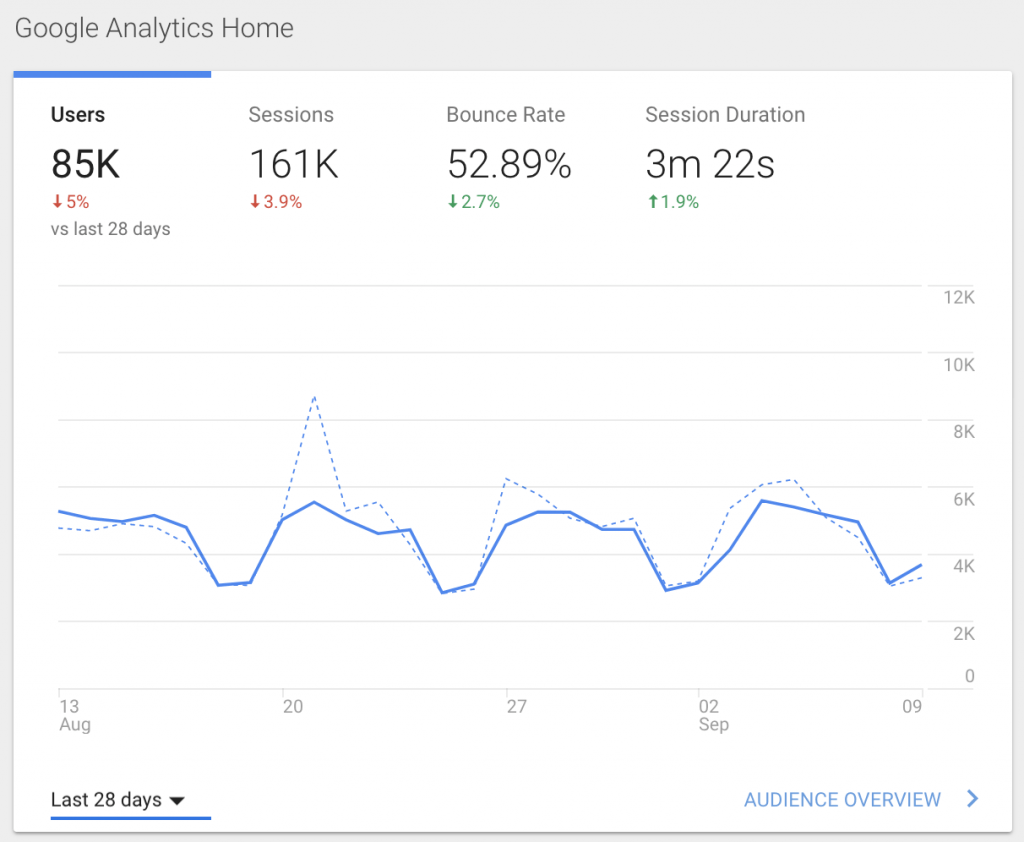
But if you see a big downward drop that doesn’t come back up, something’s wrong.
Google Analytics shows you traffic. If you haven’t already, connect Google Analytics to Google Search Console to see your rankings.
In general, Google’s information will be the most accurate. You can also use other tools to confirm the drop or add a 2nd layer of confidence. For example, you can use the HOTH’s rank tracker, the HOTH’s website traffic tool, or Ahrefs.
When you look at any of these tools, make sure that you’re looking at the correct country. If your site is targeted to capture UK-based traffic, make sure you are looking at U.K. rankings (not U.S.).
Step #3: Check Google Search Console for Errors or Warnings
How is Google crawling your website? Are there any errors or penalties?
Google will notify you of crawl errors automatically when the bots crawl your site.
Google will notify you of manual actions by their human reviewers if they flag your site’s pages
The information will be pretty straightforward. So check for errors and take care of them when they arise.
Step #4: Review Recent Changes
Do any of these possible changes ring a bell?:
New plugins
Updates on existing plugins
New site theme
New pages added
Major URL structure changes (Moving your blog?)
There might even be something de-indexing your site without your knowledge. Check to make sure this box isn’t checked in your WordPress backend:
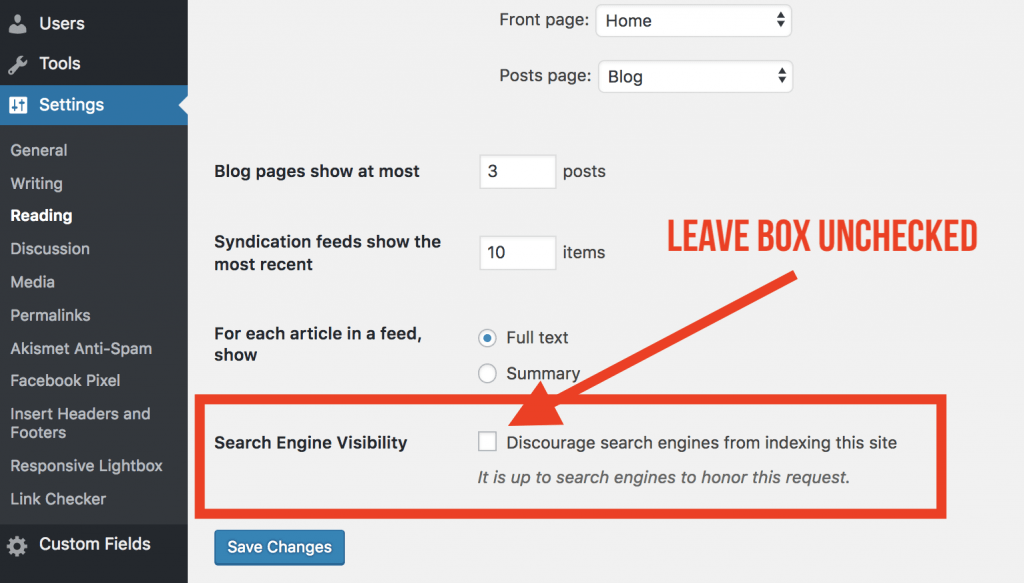
Or maybe you or someone else worked on your site and added a noindex tag. This code will similarly disallow search engines from crawling the page it’s on.
This is what a noindex tag looks like in a site’s HTML code.:

Remove it from any pages that you want to rank.
Step #5: Check for Recent Google Updates
Things shift up or down in SEO. This is the nature of SEO. And weight loss. And love. And everything in life.
Google releases multiple updates each year. So change really is inevitable.
You can look to see when your rankings dropped and use this date to check if there was a Google update around that time. If so, there’s a strong possibility that it’s the reason for fluctuations.
There are some tools you can use to check for SERP fluctuations including SEMrush’s Sensor, Rank Ranger’s Rank Risk Index, and SerpMetrics’ Flux chart:
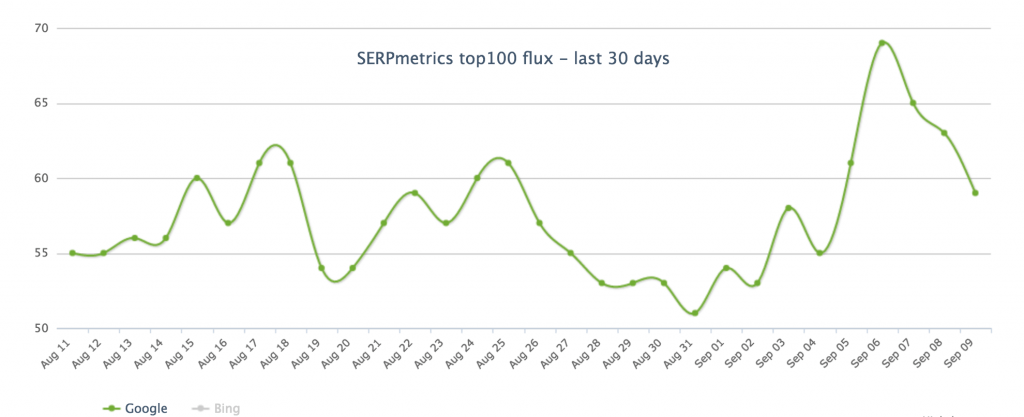
If you confirm that it was a Google update that caused your rankings to drop, try and improve your site according to what that update may have been targeting.
For example, Google’s most recent Medic update targeted a lot of sites in niches like health and finance that are held to higher standards in Google’s guidelines. Those sites had to readjust in order to better follow those guidelines.
Step #6: Identify What Exactly Dropped (and When)
Once you’ve ran through the above steps to rule them out, you can start to do some closer diagnosis to see what dropped. Was it:
A certain page: Is it just one key page that dropped?
Certain pages: Was it multiple pages?
The whole site: Did all of your pages take a hit?
Certain keywords: What keywords in particular are you targeting, which ones have started to drop, and when did they start dropping?
Check for this information using your analytics, Rank Tracker, or Ahrefs.
You can use this data to do research and identify a possible cause:
Were there any noted Google Updates around this time?
Did you stop doing any work that you had been doing consistently around this time?
Have you received any notifications in Google search console?
Is your business seasonal? For example, a Christmas website will have more traffic in
Nov/Dec rather than May.
Knowing this can help you zero in on what might be impacting your rankings.
Step #7: Check to See if You’re Being Outranked
To see whether this is the case, check:
How many backlinks does the competition have? Your aim is to beat them.
How much content does the competition have? More content usually translates into better rankings.
How many pages does the competition have? As with more content, a competitor with more high-quality pages than you might get better rankings.
You can get this information by plugging your URL and your competitors’ URL’s into Ahrefs Domain Comparison:
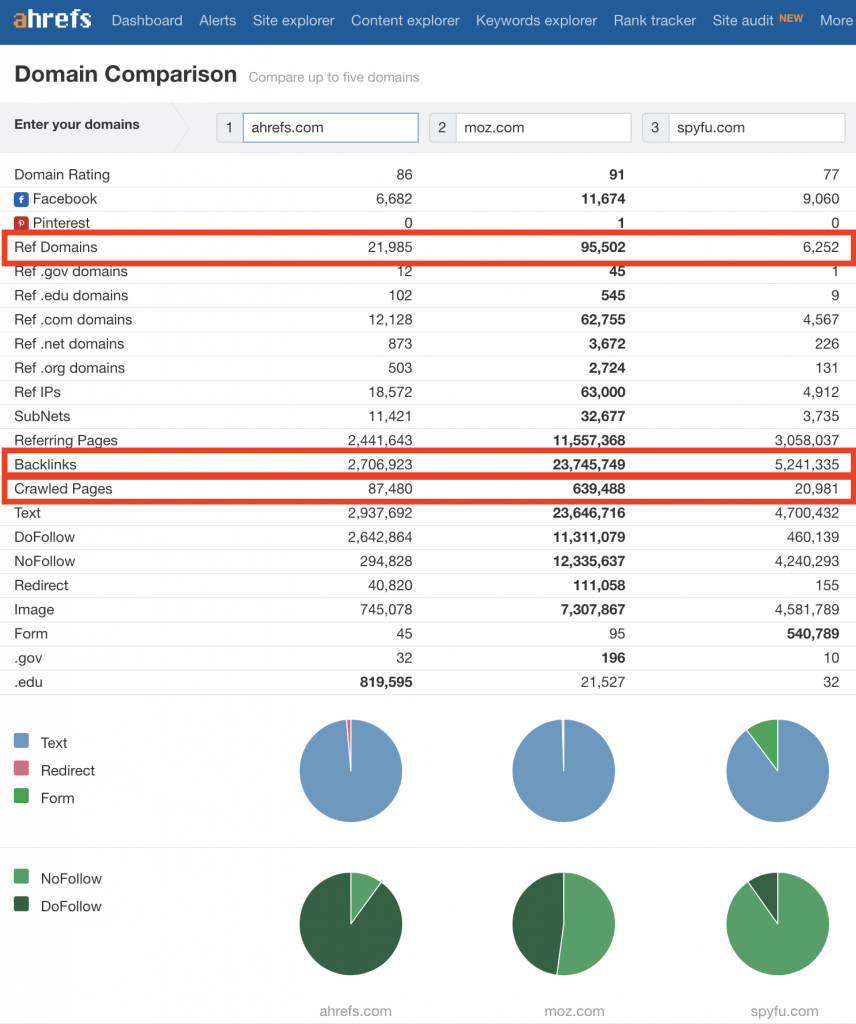
Once you’ve run through the above possibilities, you can check these specific factors to see if there’s something going on with your backlink profile or onpage optimization that needs to be fixed.
Step #8: Check Your Backlink Profile
The links pointing to your website can have an impact. Here are the things to look for:
Check for Lost Backlinks
A lost backlink from an authority site that helped pump you up can result in a rankings drop.
You can use a tool like The HOTH’s Backlink Checker, Ahrefs, Majestic, et al to check your link profile.
If using Ahrefs, go to “Lost Backlinks” and check for any specific days with an important link or abnormal number of links lost.
Double check where those links came from to see what may be affecting it. If those lost links were helping, see if you can re-establish them by reaching out to the publishers of the pages they were on.
Check for Spammy or Unnatural Backlinks
When you check your site’s backlinks, you want to be alert for certain types of links that can hurt your rankings.
You can check for this in Ahrefs by searching your website and going to “Backlinks.”
Here are some things to watch for when evaluating your backlinks:
Sitewide links: These are not necessarily spammy if they are natural and relevant. A sitewide link found in a header, sidebar, footer on another site can be completely natural. For example, a relevant blogroll link would be a natural sitewide link.
Anchor text for sitewide links pointing to you should be branded terms rather than keywords, and your site should be very relevant to the site linking to yours. On the other hand, too many sitewide links with keyword rather than branded anchor text from sites that aren’t relevant to yours can have a negative impact.
Languages: Links from China, Russia, or any non-Roman character site. 3-5 of these links are ok for a large backlink profile, however if your local pizza shop has 1,000 Russian backlinks, that’s bad.
Any sites that are similar to bookmark sites or are not “in-content” links.
If backlinks look unnatural to you, they may look unnatural in Google’s eyes. Remember to disavow any links that you receive a manual action/notification for in Google Search Console.
To improve the health of your backlink profile, focus on building more natural/in-content links and creating additional content that gets linked to.
Check IP (Location) of Backlinks
Too many backlinks coming from a single IP are unnatural in certain cases.
We sometimes see website with links from PBN (private blog network) sites pointing to them. Those sites have the same IP because they’re built on the same host, and thus are unnatural.
A lot of sites have the same IPs naturally, however. For instance, there are a lot of blogs hosted on blogspot.com pointing to us, and those are certainly natural.
So in order to determine whether the multiple backlinks coming from a single IP are natural or not:
Took for any unnatural ratios of IPs vs. Domains
Try to determine the sites where the IPs are coming from
If it looks like a number of lower quality sites, or a sidebar link from a single low-quality site with a lot of pages, you may want to disavow that link (and observe whether it creates a positive change over time)
You can check for this in Ahrefs by searching your site and going to “Referring IPs:”
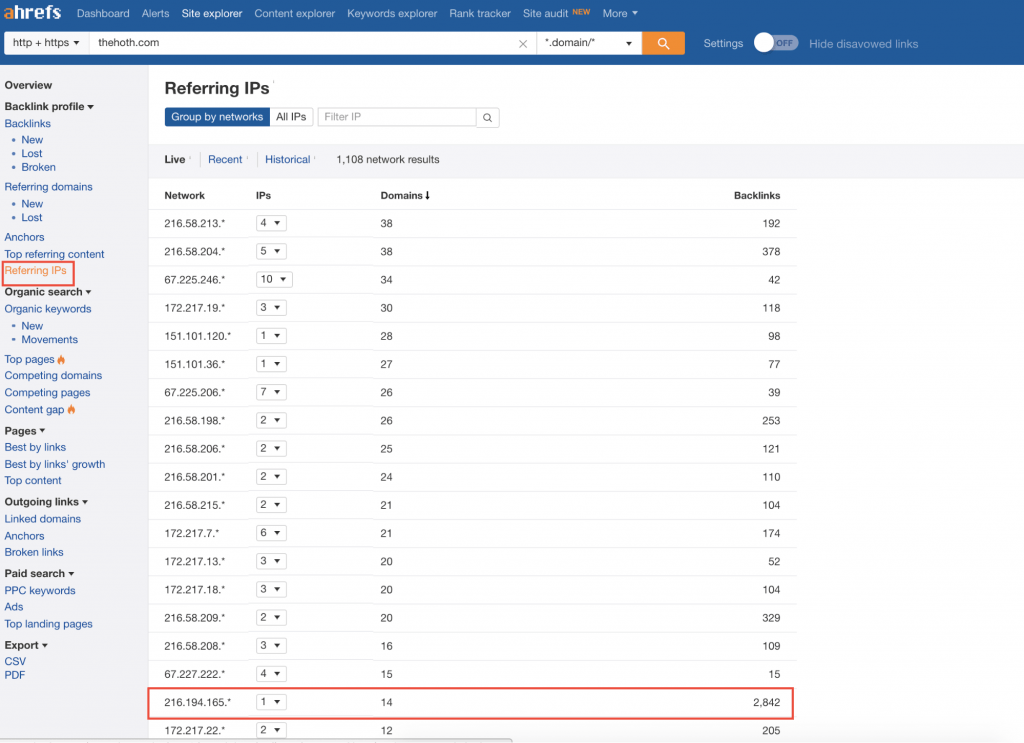
You can also search for the location of the IP using IP Location Checker.
Disavow those links to solve the problem.
Check Referring Domains Ratio
The ratio of backlinks vs. domains should be relatively proportional. You’ll usually get more backlinks than referring domains since some domains will refer to you more than once.
However, 1,000 backlinks coming from 2 Referring Domains does not look natural. These are most likely sitewide links that you should check for relevance. In that case, you should identify which sites have the most links from them to yours.
Here’s what the backlinks vs referring domains display looks like in Ahrefs:
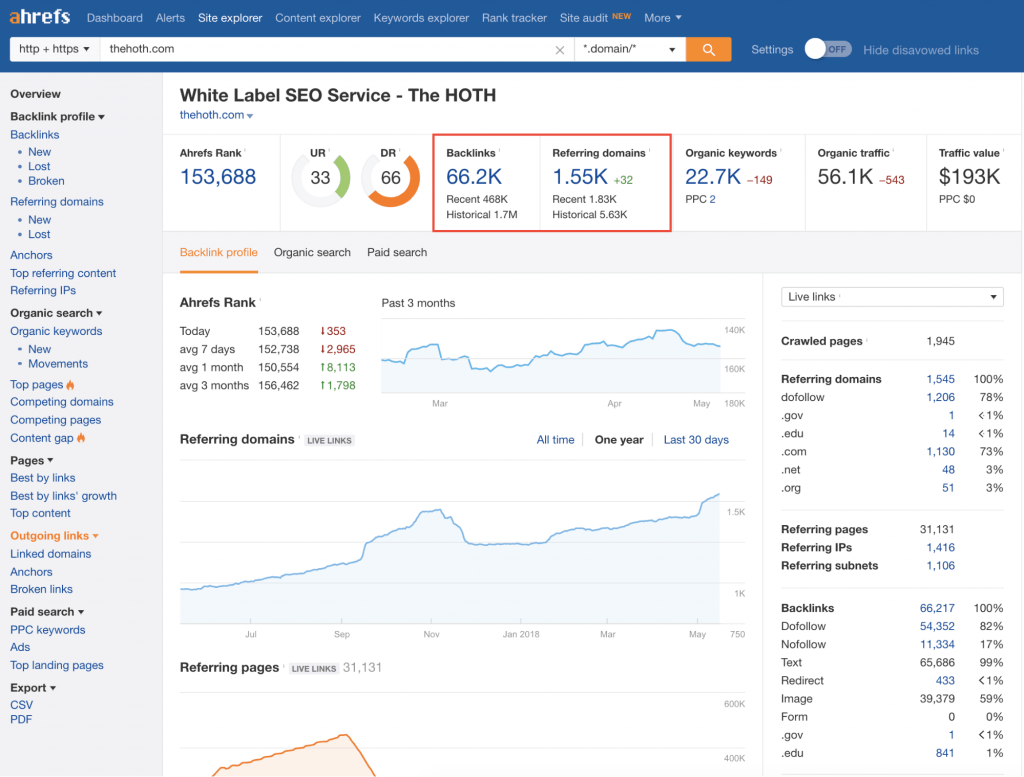
Once you’ve identified the site with too many backlinks coming from it, disavow those links.
Check Your Anchor Text Ratio
Ahrefs makes this easy to check by entering the site and going to “Anchors:
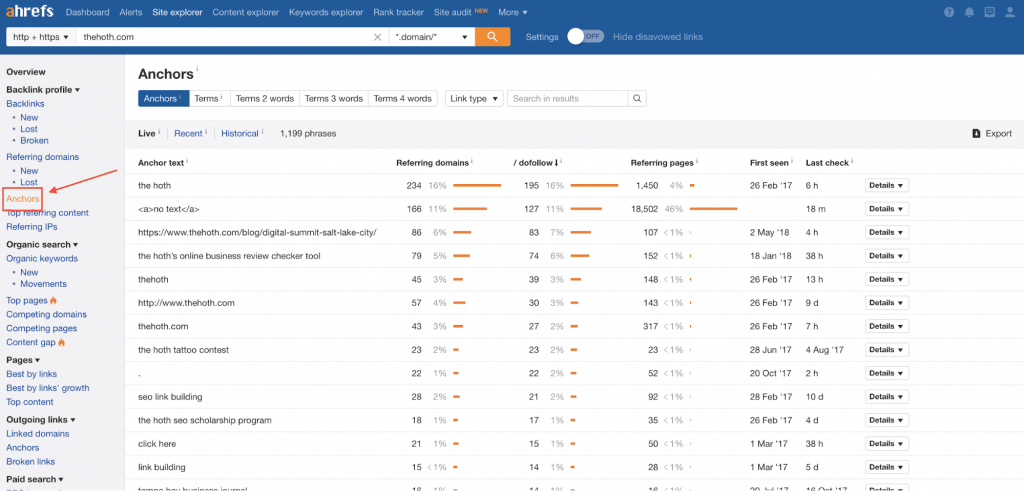
Exact match keywords should not be over 10% of referring domains or pages. Keep anchor text branded, benign (non-keywords), and naked.
Check this post for more on anchor text ratios.
Step #9: Check Onpage Factors
The content on your site’s pages can affect your rankings. Check for these on-page factors to avoid getting penalized.
Check for Thin Content on Your Site
Too many pages on your site with thin content can hurt your SEO.
To check, use The HOTH’s Word Count tool and make a sheet listing the word count of every page on your site.
For any pages less than 500 words, decide whether that page has enough benefit to your site already (for example: by having gained backlinks, or by being an important product or sales page).
Try to hit at least 1000 words by adding content to those shorter pages, or delete them from your site if they don’t benefit it.
E-commerce sites with many product pages that don’t have much description on them may appear as having too much “thin content.”
For example, Amazon.com solves this problem by including lots of content on a product page beyond its bullets and description with customer reviews and images.
In addition to fixing any thin content by adding to or deleting it, try to post new content to your site regularly that is a good length (1,000+ words).
Check Keyword Usage on Your Site
When it comes to pages on your site that you’re trying to rank for a specific keyword, check for over-optimization and under-optimization in case it’s a factor.
Over-optimization can be identified when your keyword density is greater than or equal to 25%. Use The HOTH’s Keyword Density tool by entering your URL and the keyword to check its density.
Under-optimization is the opposite: If the keyword you want to rank for can’t be found in the text of that page you won’t rank for it.
To solve over-optimization, focus on topical relevance and make sure keywords are occurring naturally in the content. You’ll also want to be sure to include LSI or secondary keywords to help indicate the page’s topic to Google.
You can use Ahrefs Keyword Explorer to find secondary terms to include:
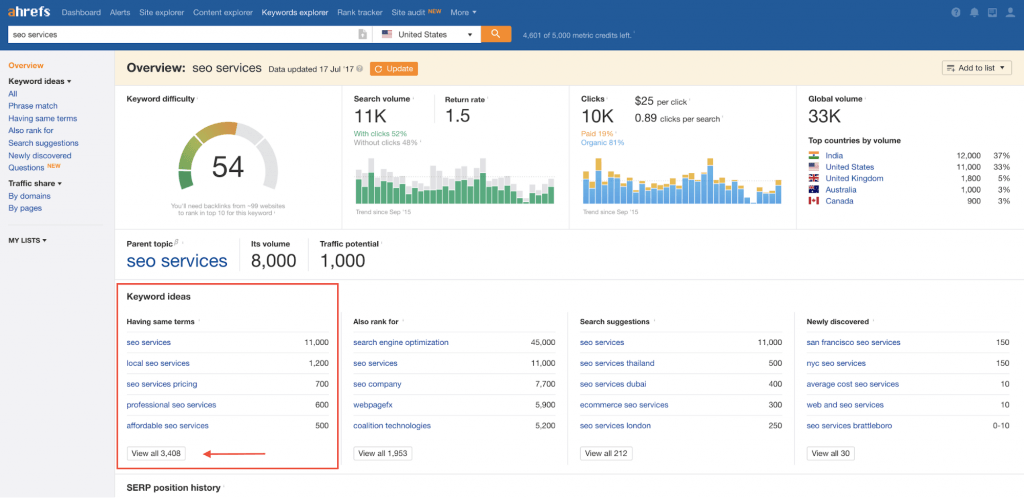
Expanding the list reveals even more terms:
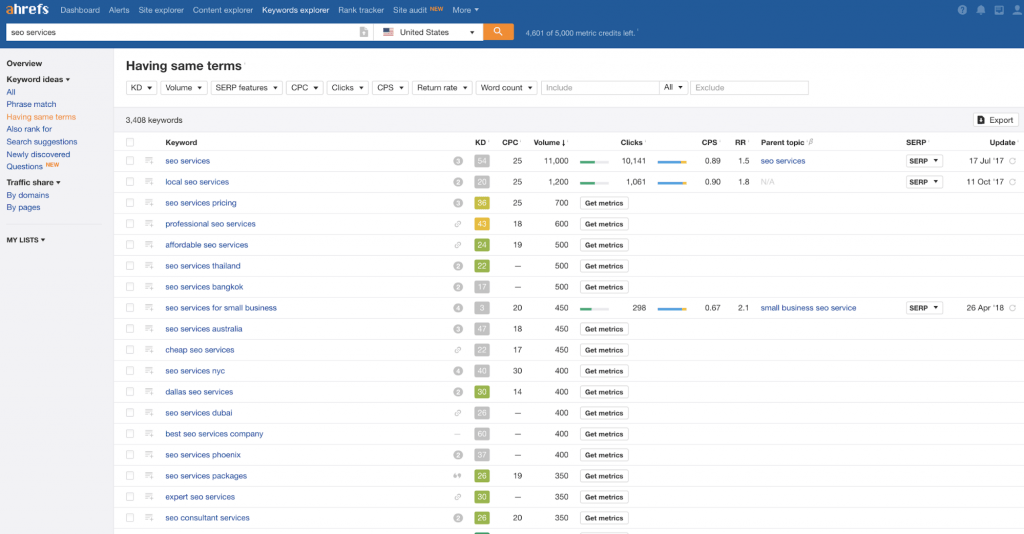
Ahrefs isn’t the only method for this. You can also use the methods in this post to find LSI keywords: here.
Finally, you can use this quick checklist to check for other on-page factors: here.
Step #10: Check in on Your SEO Activities
Maybe your rankings didn’t drop. They just aren’t growing and are staying stagnant.
In that case, you likely need to up your SEO game. SEO you aren’t doing isn’t a reason for dropping, but it could be a reason you aren’t growing.
Here are some things that could contribute to stagnant or dropping rankings:
Not doing consistent SEO work every month (such as once every 3 months). SEO needs to be done consistently over time if you want to see great results.
Adding JUST content or JUST links to your website. You need both content and links added to your site together consistently.
The competition level of the keywords you want to rank for might outweigh the work being done. Check to make sure the SEO you’re putting in matches the difficulty level of those keywords.
You can check the Keyword Difficulty (KD) of keywords in Ahrefs. It runs on a scale of 0-100:
Low Competition = KD 0 – 30
Medium = KD 30 – 70
High = KD 70+
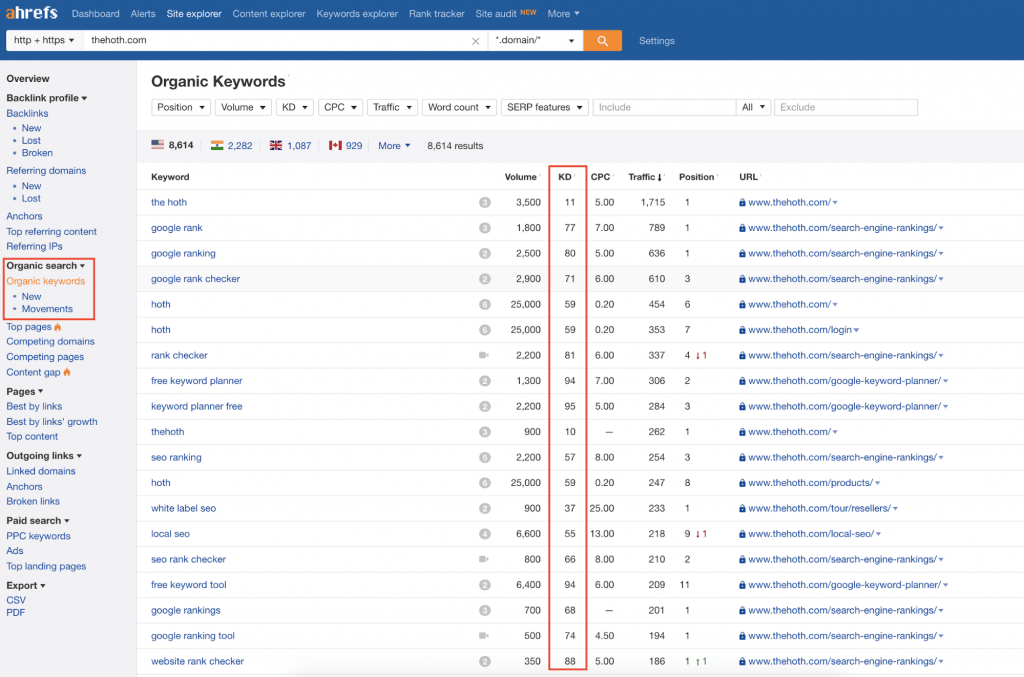
Note: Time is a factor in SEO. It can take 3 months of consistent work (or more) to see rankings start to increase. But once you put that work in and rankings start going up, they’re easier to maintain.
The bottom line here is: The SEO work you do needs to be consistent and proportional to the competition of the keywords you’re targeting. Make sure you are aware of the difficulty level to avoid having mismatched expectations.
Conclusion
Now you have a full checklist to run through when your rankings are stagnant or dropping.
Remember not to panic. You can get your site’s mojo back.
You just need to be methodical in how you diagnose your site to see what may be going on and take steps to fix it.
We help sites get their rankings back every single day here at The HOTH. If you’re still having trouble, schedule a consultation with us so that we can help your site stay on Page 1 of Google.









2 Comments
https://futurewintech.blogspot.com/p/seo.html
ReplyDeleteI want to bring traffic to this post, will you help me
Excellent clearly given content from you thank you for sharing this post, i have a question abot backlinks how many backlins submission for safe to one domain.
ReplyDeletebranding companies in hyderabad
Please do not enter any spam link into the comment box.